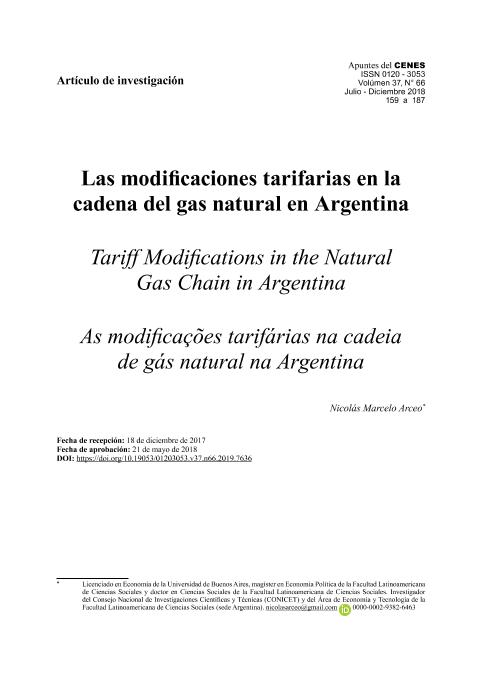Artículo
El objetivo del trabajo es evaluar el impacto de las modificaciones tarifarias en la cadena del gas natural en la República Argentina a lo largo de los últimos años. En particular, se analiza el efecto que tuvieron dichas modificaciones sobre los distintos actores que componen la cadena. Con base en este objetivo se analizaron los distintos cuadros tarifarios que rigieron al sector a lo largo de las dos últimas décadas y, en particular, durante los últimos años cuando el aumento en el precio del gas boca de pozo y la realización de la Revisión Tarifaria Integral (RTI) en los segmentos de transporte y distribución de gas natural determinaron una sensible modificación de la distribución de los recursos dentro de la cadena gasífera. En el trabajo se demuestra que el proceso de recomposición del precio del gas natural en boca de pozo tuvo por objetivo primordial reducir los subsidios que percibían las empresas productoras a través del Plan Gas I y II. Por lo tanto, el incremento de las tarifas gasíferas posibilitó una reducción de los subsidios energéticos y si bien generó una sensible transferencia de recursos desde los consumidores, el destinatario central fue el Estado nacional y, en menor medida, las empresas distribuidoras y transportistas de gas natural, en tanto las empresas productoras de hidrocarburos fueron poco beneficiadas por estas medidas. The objective of the work is to evaluate the impact of the tariff in the natural gas chain in Argentina c over the last years. The paper focuses on the effect of these changes between the different agents in the gas chain.Different tariff schedules that governed the sector over the last two decades are analyzed, particularly during the last years when the increase in the price of wellhead gas and the completion of the Tariff Review Integral (RTI) in the transportation and distribution of natural gas segments determined a significant change in the distribution of resources within the gas chain. In this work it is shown that the process of recomposing the price of natural gas in the mouth of the well had the primary objective of reducing the subsidies received by the producing companies through the Gas Plan I and II. It is concluded that the increase in gas tariffs allowed a reduction in energy subsidies and although it generated a sensible transfer of resources from consumers, the main beneficiary was the central government and, in second order, the natural gas distribution and transport companies., while the producing companies of hydrocarbons were barely benefited by these measures.
Las modificaciones tarifarias en la cadena del gas natural en la Argentina
Fecha de publicación:
06/2018
Editorial:
Universidad Pedagógica y Tecnológica de Colombia
Revista:
Apuntes del Cenes
ISSN:
0120-3053
Idioma:
Español
Tipo de recurso:
Artículo publicado
Clasificación temática:
Resumen
Archivos asociados
Licencia
Identificadores
Colecciones
Articulos (IICSAL)
Articulos de INSTITUTO DE INVESTIGACIONES SOCIALES DE AMERICA LATINA
Articulos de INSTITUTO DE INVESTIGACIONES SOCIALES DE AMERICA LATINA
Citación
Arceo, Nicolás Marcelo; Las modificaciones tarifarias en la cadena del gas natural en la Argentina; Universidad Pedagógica y Tecnológica de Colombia; Apuntes del Cenes; 37; 66; 6-2018; 159-187
Compartir
Altmétricas




